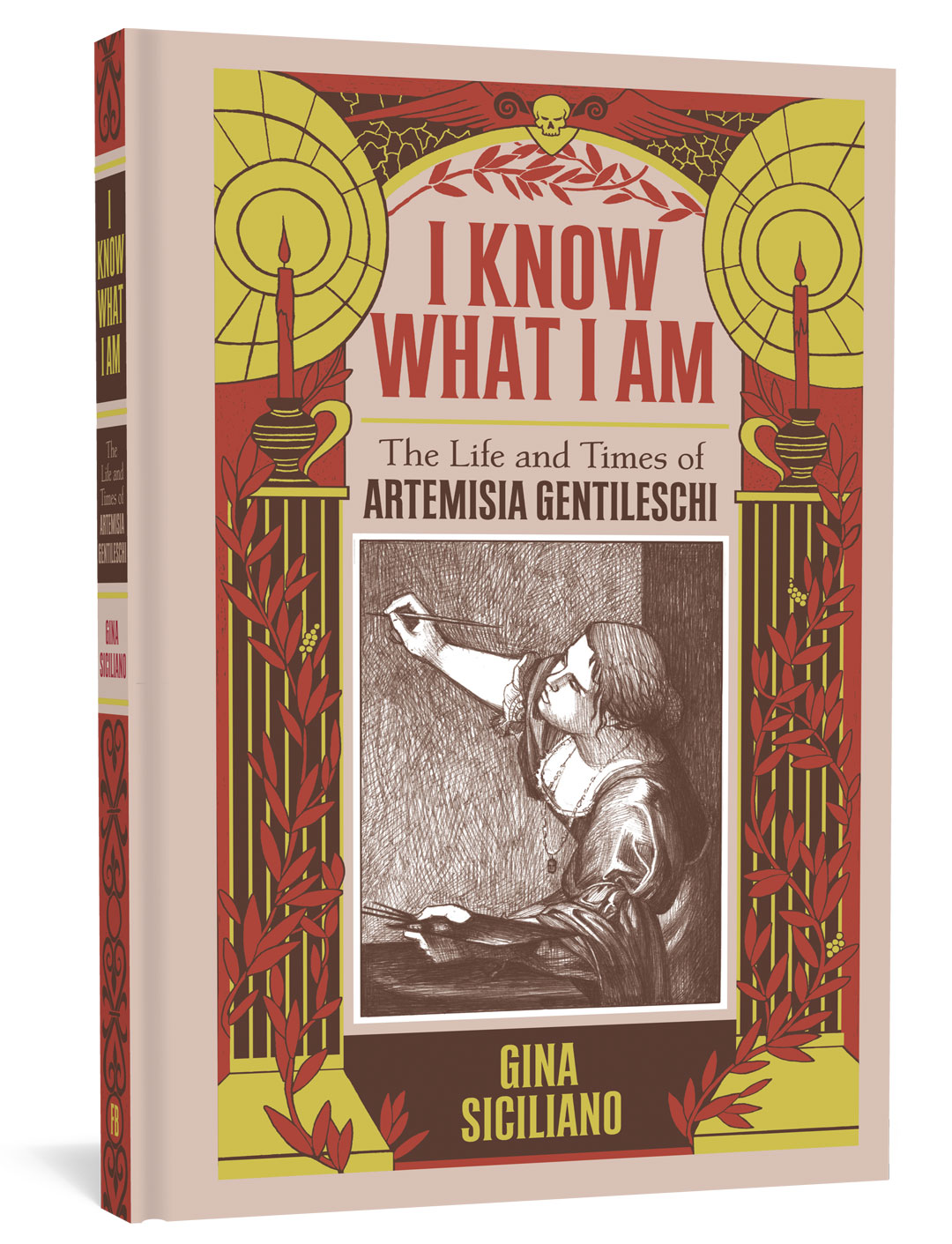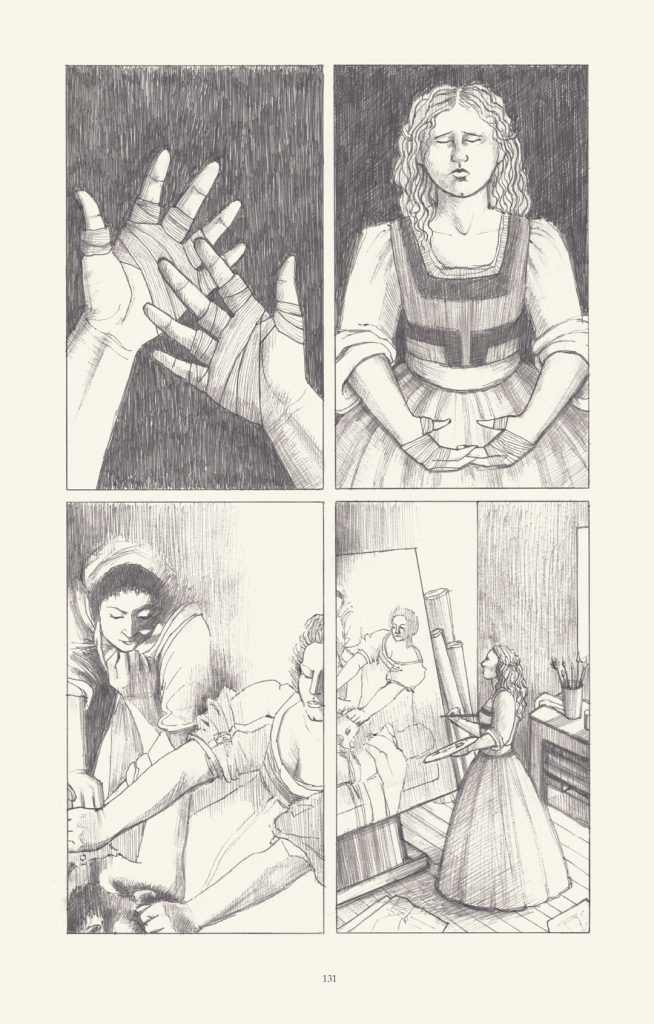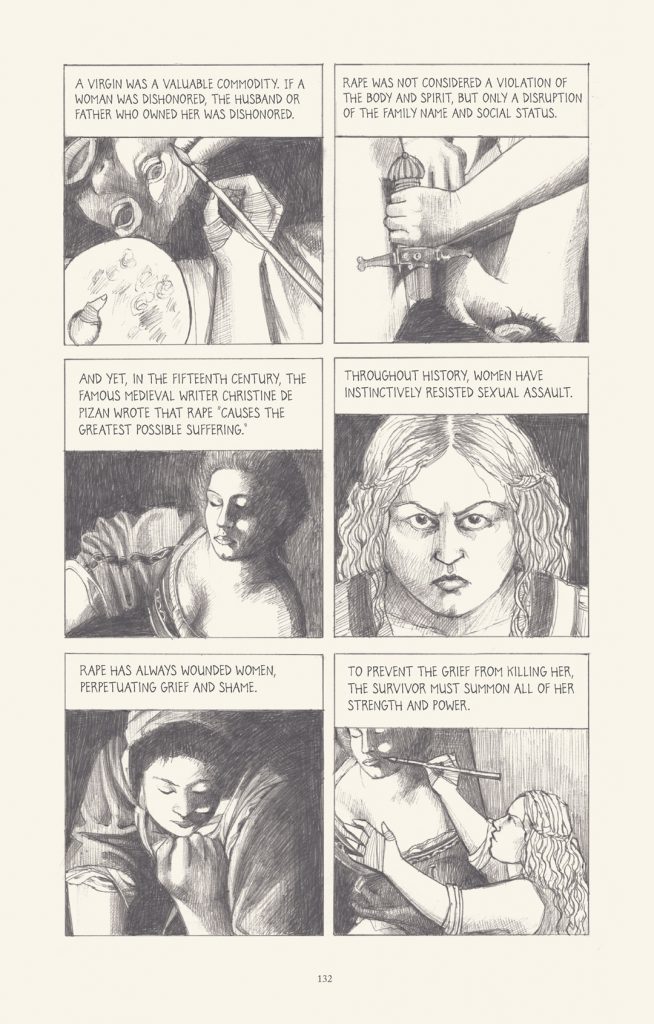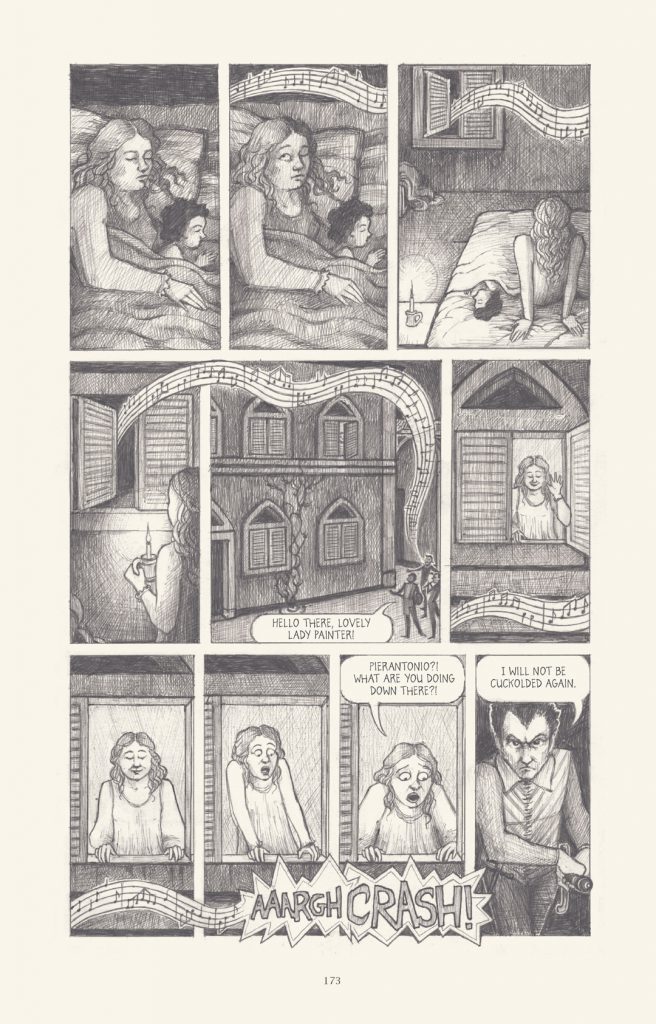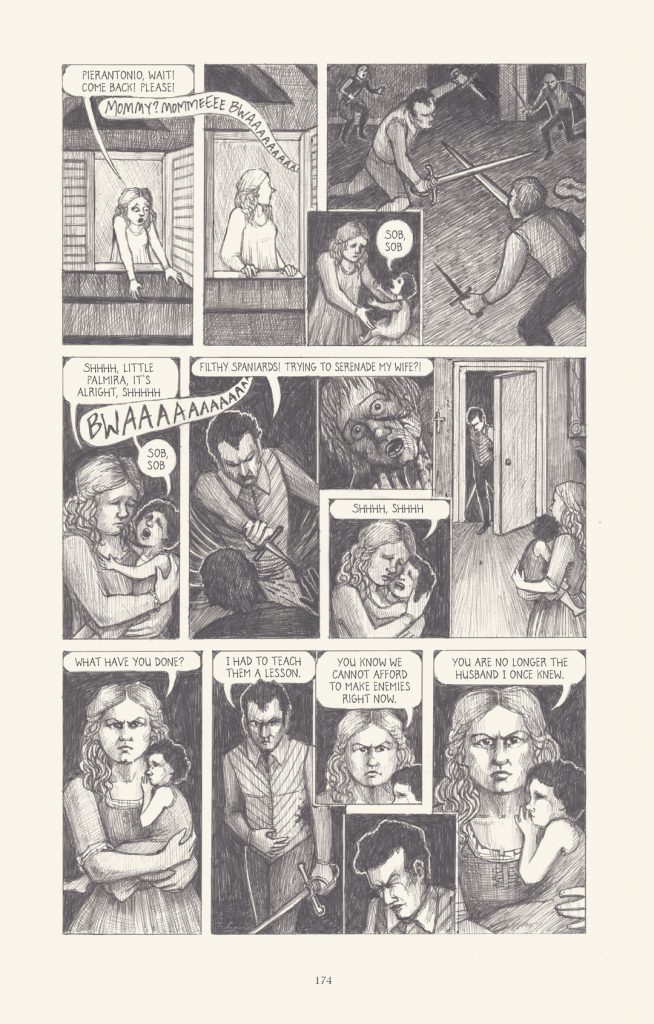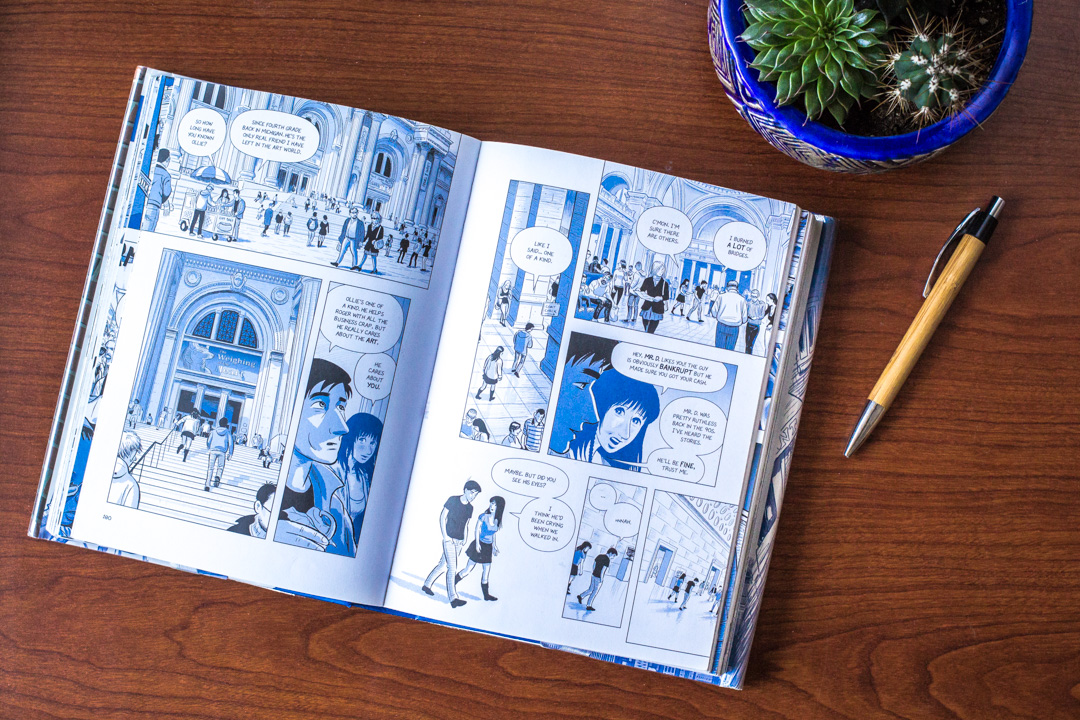In Graphic Detail: An Interview with Gina Siciliano
If you haven’t heard, Artemisia Gentileschi’s renowned painting Judith and Holofernes is currently hanging at SAM as part of Flesh and Blood: Italian Masterpieces from the Capodimonte Museum. This particular painting by Gentileschi has gotten a lot of attention in recent years as discussions of representation of women in the arts as well as rape culture have become part of mainstream media. A graphic novel, I Know What I Am: The Life and Times of Artemisia Gentileschi by Gina Siciliano was recently published by Seattle-based Fantagraphics. This Pacific Northwest illustrator and author conducted research for seven years to offer a picture of Italy’s cultural climate in the 17th century as well as an unflinching look at Gentileschi’s life whose artistic success and documented rape trial have cast her as a feminist hero in her time, one that we can still learn from today.
After giving a talk on the Contemporary Resonance of Artemisia Gentileschi at the opening of Flesh and Blood with Chiyo Ishikawa, SAM’s Deputy Director for Art and Curator of European Painting and Sculpture, and Estelle Lingo, Professor of Early Modern European Art at University of Washington, we wanted to learn more about her enthralling graphic novel. Done entirely in ballpoint pen, the book is an education in world history that is full of drama, tragedy, and passion. Italian artists in the 1600s don’t seem too hesitant about stabbing each other. Read below for more information on this talented author, feminism, and the figure of Gentileschi. If you’re planning to visit the exhibition to see Gentileschi’s painting, come on Thursday, November 21 and take a tour of the galleries with Gina!
SAM: What drew you to Artemisia? When did you realize you were making a book-length work?
Gina Siciliano: I knew immediately that I was going to make a graphic novel about Artemisia, right when I was introduced to her work in art school, and then when I first saw the Judith painting in the Uffizi back in 2007. When I was ready, I broke the story into three parts and dove in, piecing her life and times together in chronological order. Initially I wasn’t going to extend it all the way to the end of her life, but I changed my mind. I decided to make a full biography because I sensed a lack of older women characters in movies, novels, comics, media, and our culture in general. It feels like once women reach a certain age they’re just thrown out of the picture or relegated to stereotypes, and it became important to rise against that.
What’s one piece of information that got you really excited when you found it?
There were so many exciting discoveries throughout this process, it’s very difficult to choose just one example! When Jesse Locker’s book came out in 2015 that completely changed the third part, and also when Elizabeth Cohen wrote about the recently discovered handful of letters written by Artemisia and Pierantonio to Francesco Maria Maringhi around 1620. They haven’t been entirely translated into English, but Cohen revealed snippets of Artemisia’s writing in English, and it was intense and wonderful to get a sense of Artemisia’s voice at that point in her life. I got chills reading about her breakdown after the death of her children and during her harrowing journey back to Rome. I rearranged that whole section of the book after that. I’m also currently very excited about Sheila Barker’s new scholarship on Artemisia.
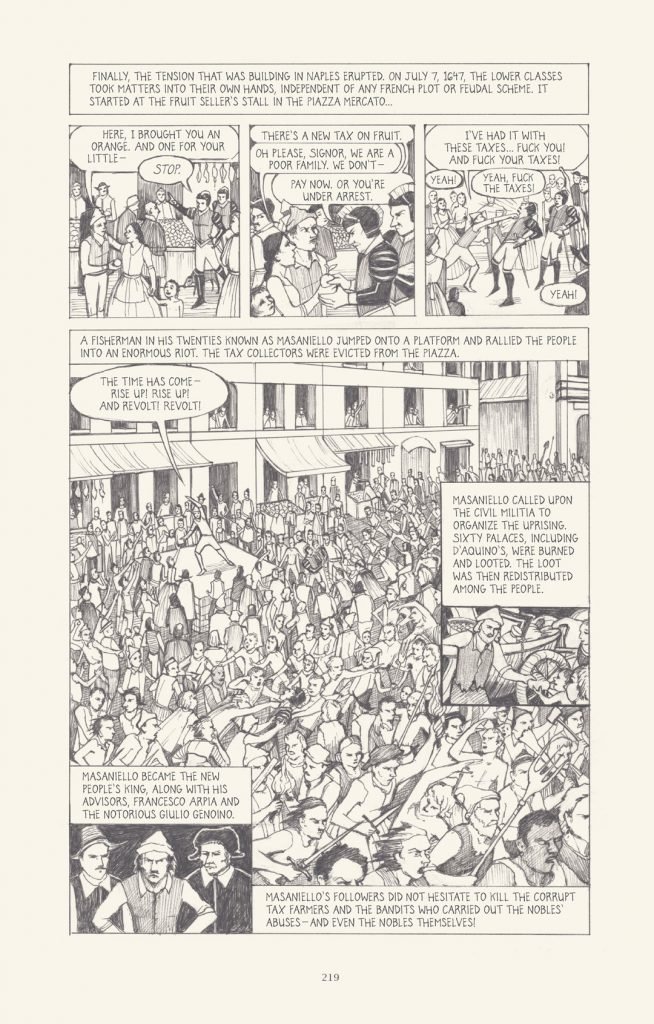
But if I had to pick the most exciting discovery of all it would be the 1647 revolt of Masaniello! Rosario Villari’s book on the subject was a landmark for me, and since there’s so little information in English I read his book several times, taking extensive notes. I was struck by the Neapolitan people’s desperation, and the way they repeatedly rose up violently against severe oppression and corruption. I was startled to learn that Artemisia survived a ten-month revolution, and it had barely been mentioned in my sources at all.
There seem to be many versions of Artemisia’s life. The details of female life were not much documented at the time so how did you decide to present the version of her life that you did?
The goal was to stay as historically accurate as possible and invent as little as possible. I was influenced by Alexandra Lapierre’s approach. She spent five years doing research in various Italian archives, then strung together the holes in the information—the gaps in history—with fiction. Rather than project my own agenda onto Artemisia or use her story as a jumping-off point for my own artistic expression, I wanted to find out as much as I could about Artemisia—how she felt, how she lived, how she interacted with others. I see her as inseparable from Italian history. I wanted to re-create her world, and then put her into it. The goal was to put her life and work into context, not take her out of context. That being said, of course, bits of myself and my own outlook slipped in all over the place. But I included a big notes section, to show the reader that we’ll never know exactly what happened—all we can do is continue to discuss how we come to conclusions, how we piece together history based on a variety of sources, ideas, and perspectives. My version of Artemisia is based on academic research, as well as my personal, emotional connection to her work.
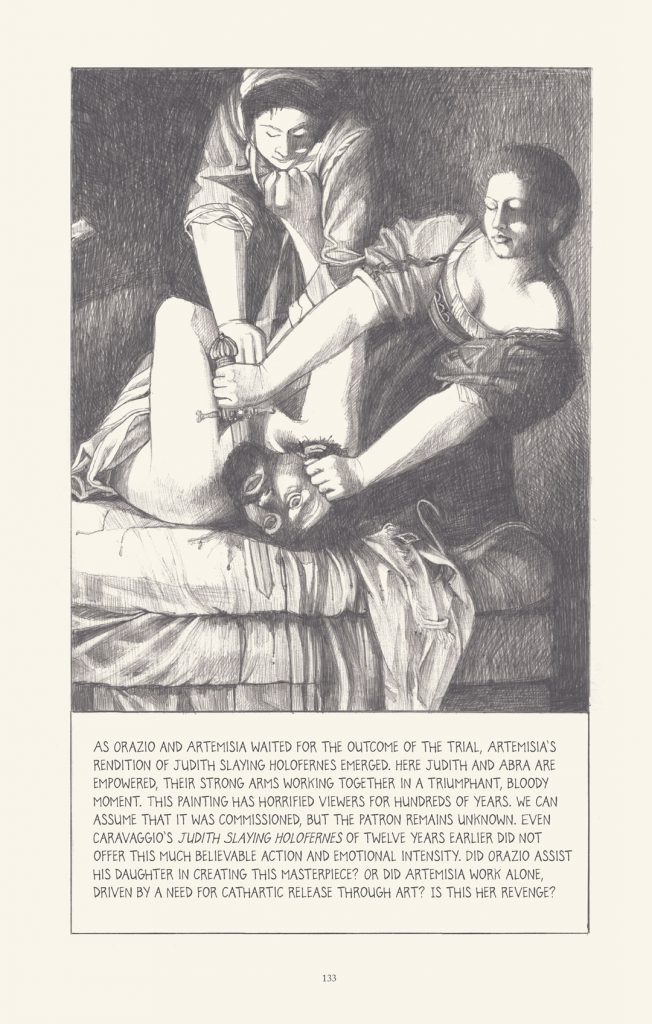
What about the decorative symbols and icons in the full-frame character illustrations?
Each one of these full-page portraits is comprised of Renaissance and Baroque symbolism, and also my own impressions. Each one has its own mood, based on the character’s role in the story. Some of these people—Caravaggio, Orazio, Artemisia, Galileo, the Duke of Alcala, Masaniello—we know quite a bit about, so I had a lot to work with. For example, Masaniello was a fisherman, so there are fish surrounding him, Galileo has a diagram of the Copernican view of the cosmos above him, etc. For these people, I used images of them from their own time to re-create how they looked. But other figures—Loredan, Arcangela Tarabotti, Tuzia Medaglia, Giovanni Battista Stiattesi, Artemisia’s daughters—are more mysterious. I had to do more inventing and cobbling together whatever scraps of information I could, to show what they might’ve looked like.
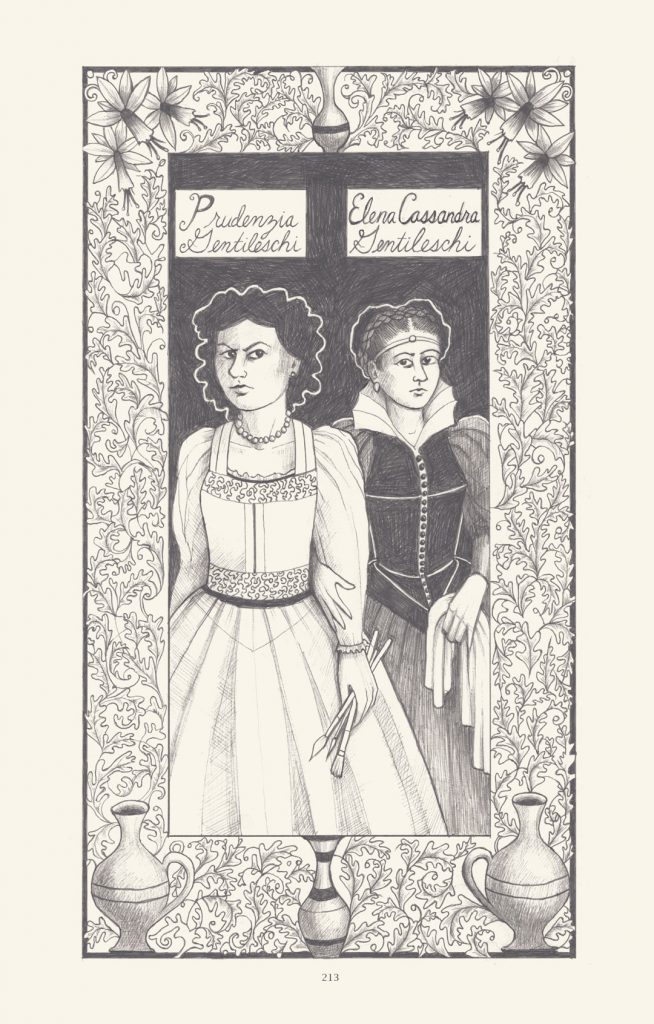
There isn’t space here to describe all the symbolism, but I’ll give a few examples: Artemisia’s daughters are shown with large, rounded, upright vessels—a common Renaissance symbol for chastity and sexual purity, whereas a spilled, horizontal vessel was a symbol for sex and impurity. The Duke of Alcala is surrounded by fig trees—lush and full of fruit—a Renaissance metaphor for sexuality again, in this case, male virility. Pierantonio stands below two bull skulls, alluding to his being a cuckold (Loredan’s epitaph about Artemisia on page 224 claims that she carved the horns of a cuckold for her husband). The glowing candles foreshadow Pierantonio’s later night-time swordplay. The characters with close ties to the Medici—Francesco Maria Maringhi, Christine of Lorraine, Maria Maddalena of Austria, Galileo—all feature the Medici’s famous logo/crest—a group of small, round, fruit-like balls. Loredan’s portrait is surrounded by water since he serves as an introduction to Venice, and below him is the logo of his famous academy (the Incogniti)—the mysterious Nile River, the source of which was still unknown at the time.
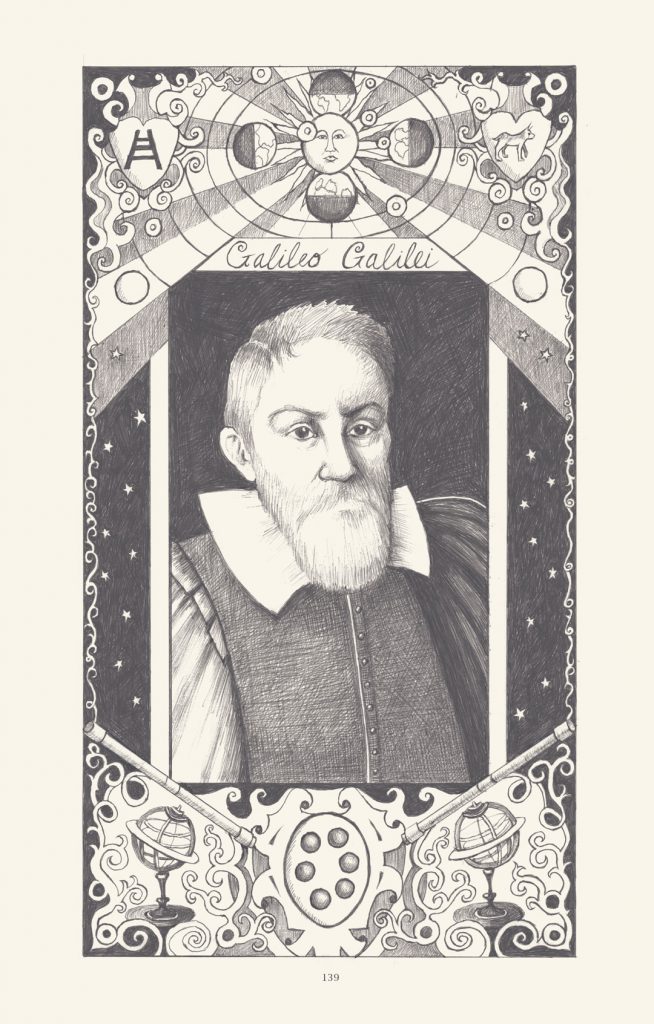
Can we have a feminist hero and still have context and historical time and place?
My book is meant to present a loud and enthusiastic YES to this question!
Will you talk a bit about proto-feminism?
This is essentially an earlier version of feminism. To me, the best biographies don’t idolize or sentimentalize the subject, nor do they gloss over the inconsistencies and contradictions of a person. Rather, they go deep into history and analyze their subject’s position, and all the potential factors that made them who they were. I love Paul Avrich’s writing about anarchists for this reason. I’m also reading Lily Tuck’s wonderful biography of Elsa Morante. Elsa Morante was an incredibly independent Italian woman, one of the first to wear pants! At the same time, Tuck mentions how Morante chastised another woman for having hairy armpits and sometimes scorned the feminist movement. I tried to be open to these types of contradictions when writing about Artemisia too. There’s reason to believe that Artemisia was a militant Catholic who didn’t always treat her servants very well. But she also wrote about the disadvantages she faced as a woman, she refused to let Agostino Tassi (the man who raped her) off the hook during the trial, and we know that she worked within the same circle as the Venetian Libertines who talked a lot about the roles of women (the querelle des femmes). We can judge Artemisia by the standards of her own time, and we can judge her according to the standards of our time. I think there’s room for both.
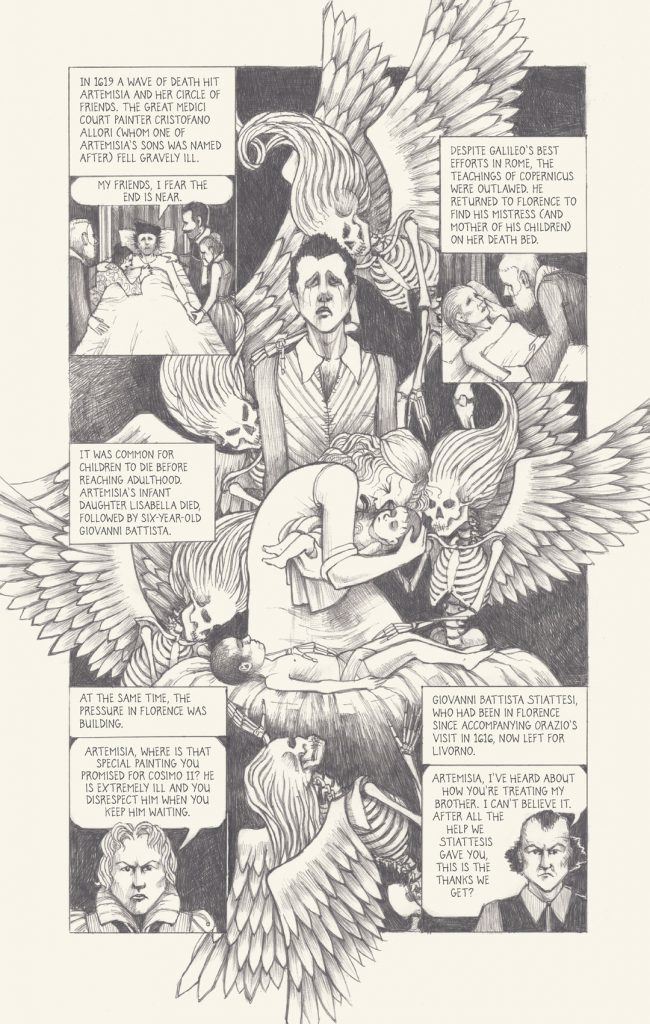
Proto-feminism didn’t look like our modern first-, second-, or third-wave feminism. There wasn’t a political movement, it was more social. There was an ongoing intellectual debate about women and plenty of writing about women’s rights. Most of the early modern feminist writers made their point by listing numerous examples of virtuous women from the bible and ancient history and mythology, as these were the touchstones of Italian humanist and Counter-Reformation thought. Sometimes they listed contemporary examples too. But, as powerful as these lists of women were, they also conformed to the proper (men’s) definition of honorable women. Even the most outspoken feminists of the time, like Arcangela Tarabotti, used only the most chaste, angelic examples of women to argue for women’s rights. But she was trying to refute the prevailing notion that women’s sexuality was toxic, out of control, and evil (Eve and the original sin, remember?). Her argument that women are inherently pure and chaste seems weird to us (like we don’t even get to have our own sexuality?), but in that intensely Catholic environment it makes sense. That’s only one aspect of her writing, and I would argue that her feminism is still important.
Likewise, we can see that the powerful Medici women—Christine of Lorraine and Maria Maddalena of Austria—were, like most queens and noblewomen, arranging marriages within their courts to solidify their family’s (and their own) wealth and power. But this doesn’t negate the radical way in which they intervened to prevent domestic violence, and their attempts to give women some say in who they would marry. That meant a lot within a society where marriage had very little to do with choice, especially among the upper classes.
At first glance, Artemisia’s world looks like a grim, unrelenting, misogynist hell hole, but when we look closer and dig deeper, we can see that women (and men) were pushing back against the status quo in all kinds of ways. The fact that so many powerful men got behind Artemisia, aided her career, and continually bailed her out (Orazio, Francesco Maria Maringhi, Cassiano dal Pozzo, Galileo, etc.) also says a lot. These men probably saw her as an exception to the norm—an exceptional woman—rather than seeing women collectively as equals. Artemisia probably saw herself as an exception to the norm too, and probably capitalized on that to a certain extent. But I still think the roots of feminism lie in these early attempts to widen the expectations of what women were capable of. Plus, there’s still so much we don’t know. Feminist scholars are trying to bring a lot of buried, unknown, misattributed, and misrepresented women’s writing, art, and music to light. This is an ongoing process, an ongoing discussion.
What is your favorite Artemisia painting?
Oh geez, I don’t know! I guess the second Judith Slaying Holofernes in the Ufizzi. There’s just nothing else like it in the world.
– Chelsea Werner-Jatzke, SAM Content Strategist and Social Media Manager
